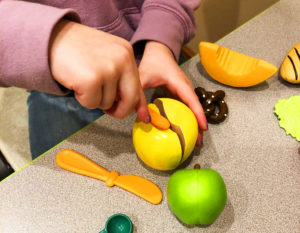Activity Analysis Breakdown: Occupational Therapy
 Do you ever wonder what your therapist is working on when they appear to be “just playing”? This child appears to only be playing. However, read on for an activity analysis of the skills the child is practicing from an occupational therapy perspective.
Do you ever wonder what your therapist is working on when they appear to be “just playing”? This child appears to only be playing. However, read on for an activity analysis of the skills the child is practicing from an occupational therapy perspective.
Play
Play food provides a wonderful opportunity for social engagement during play. During this activity, a therapist is handing the child pretend kitchen utensils. They are also requesting items to promote eye contact, engagement, and back and forth play. The therapist plays alongside the child, utilizing the same utensils and pretend food to engage them. The therapist watches to see if the child can tolerate sharing materials and playing in the same vicinity as the therapist (parallel play). Play expands further by modeling pretend “cutting” of the fruit and subsequently feeding a stuffed animal sitting on the table. The therapist hopes to see the child imitate this new play scheme. This will eventually lead to the ability to initiate these skills independently.
Fine Motor Activity Analysis
During this activity, a child practices their “power grasp”. It is used to manipulate items similar to a toy hammer or a pretend kitchen knife. This grasp is used when strength is needed from the ulnar (or pinky) side of the hand to manipulate such items. The strength and stabilization comes from the grasp of the pinky, ring, and middle fingers around the handle of the object and the thumb and pointer finger allow for control and manipulation of the object.
 Attention
Attention
During this play activity, the child works on sustained and joint attention. This particular child has been working on requesting her needs or wants through play by utilizing gestures and/or vocalizations (i.e. asking for “more” or pointing to items wanted). This child is working on sustaining attention in order to learn pretend and symbolic play. This child was able to sustain her attention to play between 5-10 minutes before abandoning the activity. While the child demonstrates preference for solitary play, they were able to stay engaged secondary to therapist modeling and facilitation of successful play skills.
To learn more about occupational therapy, check out our What is Occupational Therapy? series, Part 1 and Part 2.
